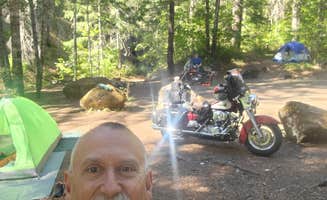Dispersed camping areas near Stayton, Oregon provide primitive outdoor experiences within the Willamette National Forest. The terrain features dense evergreen forests, volcanic rock formations, and elevations ranging from 1,200 to 3,800 feet. Seasonal road conditions vary significantly, with many forest service roads becoming impassable during winter months due to snow accumulation or spring runoff damage.
What to do
Fishing opportunities: At Britenbush River Dispersed, campers can access multiple water recreation spots. "Awesome little cliff jumping swimming spot to teach the kids how to swim," reports Daniel W., highlighting the varied water depths suitable for different skill levels.
Creek exploration: The dispersed sites along forest roads provide access to smaller waterways for wading and wildlife observation. The surrounding creeks offer natural cooling during summer months when temperatures regularly exceed 85°F in July and August.
Wildlife observation: Early morning hours provide optimal viewing times for deer, elk, and numerous bird species throughout the camping areas. Motion-activated trail cameras set 100+ yards from campsites have documented increased wildlife activity between 5:30-7:30am.
What campers like
Natural privacy: Many sites offer natural separation through forest vegetation and terrain features. "Dispersed camping is the best camping. Free, quiet, and new. Show up whenever you feel like - it belongs to everyone," mentions Eva W. about Alder Flat.
Water access: Multiple sites provide direct water access for cooling off during summer months. "We crossed a few foot bridges and it opened up to a fairly good sized camping area with some scattered fire rings. Great view of the water just across a dry creek bed and over the hill," notes Alison S.
Quiet environment: The remote nature of these sites creates natural sound barriers from urban noise. "You are immediately ensconced in quiet and shade, an impossibly green and detailed large pond right off the bat, with a huge walkable log going right to the middle," reports Bjorn S. when describing trail access to camping areas.
What you should know
Fire safety requirements: Forest Service regulations require specific equipment at all dispersed sites. "Be prepare for fire danger, have axe, shovel and 5-gal of water, you will be the first to stop it and report it," explains Cindy U. about Quartzville Recreation Corridor.
Limited cell coverage: Communication becomes increasingly unreliable as you travel deeper into forest areas. Cell service typically diminishes significantly beyond primary roads, with most sites having no reliable connection.
Post-wildfire conditions: Several previously popular areas remain severely affected by recent burns. "I used to go here before the fires closed it for a couple years. We went back summer 2023 and there were big downed trees on the trail that took a lot of effort to get over," reports Emily about Round Lake Campground.
Tips for camping with families
Site selection: Choose pull-outs with established clearings for safer family camping experiences. "I have camped at the quarry a few times with my friends that have a camp trailer. I have also camped in the pull outs," shares Hahns R., noting the variety of site options available.
Water safety planning: Designate specific water entry points before arriving at swimming areas. Creek and river temperatures remain cold even during summer months, rarely exceeding 60°F in most locations.
Pack-out preparation: Bring designated containers for all waste management. Most free camping near Stayton requires complete pack-out of all materials including used water and food waste.
Tips from RVers
Road conditions: Forest Service roads leading to dispersed sites vary dramatically in quality. "Beautiful recreation area... Mostly roadside limited facilities and or services but beautiful area... windy narrow road... limited places to turn around," warns Len S. about accessing Collawash River Dispersed Campsite.
Solar considerations: Position RVs strategically to maximize solar collection if using solar power. "The sites are open, so good for solar, but do get windy," notes Hahns R. about energy options at dispersed sites.
Size limitations: Most dispersed camping pullouts accommodate smaller rigs only. Measure total vehicle length before attempting access, as most sites cannot accommodate rigs longer than 25 feet due to limited turnaround space.


